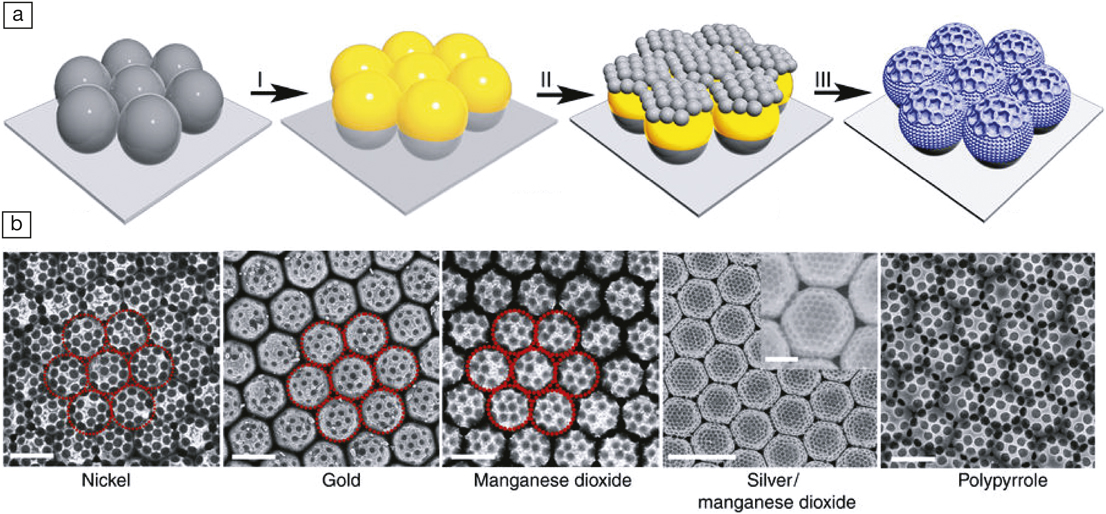A group of researchers led by Tak-Sing Wong at The Pennsylvania State University synthesized the complex brochosome structure found in leafhopper insects. Published recently in Nature Communications (doi:10.1038/s41467-017-01404-8), their method controls the size of the many features of the structure, scales easily to larger volumes, and can be adapted for many different materials. These qualities make their synthetic brochosome useful for solar energy, sensing, and photocatalytic applications.
Examples of micro- and nanostructured surfaces abound in nature. Carnivorous plants secrete a liquid film on their microtextured leaves that causes insects to slip into their traps. By replicating these coatings in the laboratory, scientists can create anti-adhesive coatings for many applications. Sometimes, researchers must devise a novel process to synthesize the natural architecture.
The brochosome, a microscopic structure synthesized by leafhopper insects to cover their bodies and eggs that resembles a hollow soccer ball, is an example of the latter. Shikuan Yang, formerly a postdoctoral candidate in Wong’s laboratory and now a professor at Zhejiang University, discovered a synthetic approach to form similar structures in the laboratory. First, a monolayer of micron-sized spheres is deposited. These are then coated with a second layer of smaller nanometer-sized spheres. A material of choice is electrodeposited into the double-sphere template. Finally, the spheres are removed, leaving a brochosome-like structure of the material of choice.
According to Silvia Vignolini of the University of Cambridge, Wong’s work stands out because his group has produced hierarchical structures comprising both micron- and nanometer-sized features, using different materials, in a simple, scalable way. The size of these features can be controlled by the spheres used in the template. By electrodepositing the material onto the double-sphere template, the synthetic brochosome can be made from a wide range of materials. Wong’s group demonstrated some of the possibilities by synthesizing brochosomes made from gold, nickel, manganese dioxide, and polypyrrole. Furthermore, the template formation and electrodeposition are easily scalable, and are essentially only limited by the surface area of the liquid on which they occur.
“If we had a swimming-pool-sized container, we could grow brochosome particles across the entire liquid surface [of the container],” Wong says.
Wong’s group also identified a previously unconfirmed use of brochosomes: shielding leafhopper insects’ eggs from predatory insects, such as the ladybird beetle. Leafhopper eggs are covered with brochosomes that make them indistinguishable from bare leaves to the ladybird beetle, whose vision is significantly different from humans.
In the future, Wong hopes to continue collaborating with biologists to solve other problems at the intersection of biology and materials science. For example, Wong imagines further studying the variations between brochosomes of different leafhopper species. “Do they absorb a certain wavelength [of light] so that they can avoid a predator in a specific geographic location? We have a tool to study that,” Wong says.

(a) Fabrication process of the synthetic brochosomes. I. Gold evaporation. II. Preparation of brochosome template. III. Electro-chemical deposition which creates brochosomes after template removal. (b) Scanning electron micrographs showing various brochosomes fabricated from nickel (Ni), gold (Au), manganese dioxide (MnO2), silver/manganese dioxide (Ag/MnO2), and polypyrrole (PPy). Scale bars: 2 μm (Ni, Au, MnO2, PPy) and 5 μm (Ag/MnO2, inset, 2 μm). Courtesy of Nature Publishing Group.
The simplicity and scalability of the synthetic brochosomes offers many options for novel applications. The concave nature of the nanoscale features in the brochosome lends itself to trapping solar energy and heat. Because the size of these cavities can be changed easily by choosing different sized spheres in the template, Wong wants to try capturing light across the electromagnetic spectrum, potentially even mid-infrared light. Yang mentions developing the brochosome films as a versatile substrate for surface-enhanced Raman scattering with extreme sensitivity. Vignolini also sees photocatalysis as a potential application for these structures because of their hierarchical nature and ability to absorb light across the electromagnetic spectrum.


